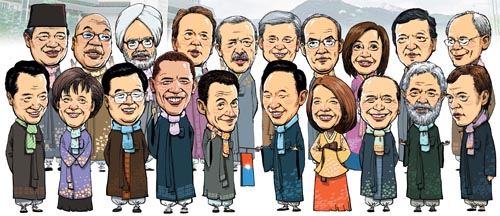G-20 is where leaders can pair off

JoongAng Ilbo cartoonist Kim Hoe-ryong’s caricature of G-20 leaders. From left in the back row, Indonesia’s Yudhoyono, South Africa’s Zuma, India’s Singh, U.K.’s Cameron, Turkey’s Erdogan, Canada’s Harper, Mexico’s Calderón, Argentina’s Kirchner, the EU’s Barroso and Rompuy. From left in the front row, Japan’s Kan, Germany’s Merkel, China’s Hu, U.S.’s Obama, France’s Sarkozy, Korea’s Lee, Australia’s Gillard, Italy’s Berlusconi, Brazil’s da Silva, Russia’s Medvedev.
The main spotlight of the G-20 Seoul Summit shines on the global issues that all 20 members hope to solve, or at least argue over, such as currency wars or current account imbalances.
But increasingly, multilateral meetings like the G-20 are becoming important venues for leaders to pair off and discuss more specific issues between their countries. That trend is most intense this week in Seoul.
“Although the G-20 has common issues to deal with, this gathering of many leaders is becoming an important stage for bilateral diplomacy,” said Kang Won-taek, international relations professor at Soongsil University.
On the sidelines of the main event, limousines are busy bringing leaders to each others’ hotel suites, making the most of what is becoming the world’s most powerful diplomatic gathering.
U.S. President Barack Obama, apart from his meeting with Korea’s President Lee Myung-bak, met Chinese leader Hu Jintao and German Chancellor Angela Merkel yesterday. Australian Prime Minister Julia Gillard met her Canadian and British counterparts, Stephen Harper and David Cameron. Japanese Prime Minister Naoto Kan is scheduled to meet the leader of the European Union tomorrow morning, according to a diplomatic source.
There is no official data, but more bilateral meetings are being arranged between countries with each G-20.
As host, Lee probably will have the most bilateral meetings: nine over the next few days. And his own experience at G-20s shows the increasing popularity of bilaterals. In the first G-20 leaders meeting in Washington in November 2008, Lee didn’t even get a bilateral with Obama. At the second summit in London in April 2009, he met Obama and Hu. At the third in Pittsburgh in September 2009, Lee met the leaders of Canada, China, Japan and Mongolia.
Choi Jong-kun, professor at Yonsei University, said countries are realizing the efficiency of bilateral talks at multinational events.
“The leaders are more blunt about what they want and what they don’t want when having a bilateral meeting during a multinational event because there is a so-called ‘audience effect,’” Choi said. The “audience” are the other world leaders in town who could be counted on to back a leader’s position.
There’s also a cost-saving effect, Choi said. It’s much cheaper to talk to several leaders in a couple of days than to jet around the world. Bilaterals are still most common among G-8 countries, but there are growing exceptions. The U.K.’s Cameron was scheduled to meet Manmohan Singh, India’s prime minster, in Seoul. Singh is also seeing Meles Zenawi, prime minister of Ethiopia, and Mexico’s President Felipe Calderon.
“Two days is such a limited time to have it all done,” said Lee Jun-han, international politics professor at University of Incheon. “But as more weight is given to less developed, but fast-growing, economies, leaders will try bilateral meetings with a wider array of counterparts during the next G-20 Summits.”
By Moon Gwang-lip [joe@joongang.co.kr]










with the Korea JoongAng Daily
To write comments, please log in to one of the accounts.
Standards Board Policy (0/250자)